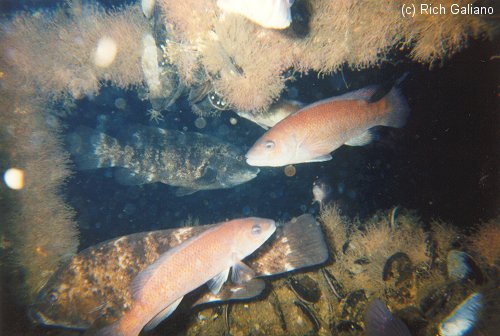Cunner
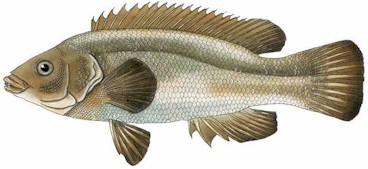
Tautogolabrus adspersus
Cunner - A Profile
by Stacey Reap
A regular reef-system resident, the cunner (tautogolabrus adspersus) does not enjoy quite as glamorous a reputation as its close relative the highly prized tautog, but the two fish share many similarities.
Also commonly known as bergall, cunner share the tautog's single long dorsal fin, the anterior majority of which harbors a series of spines that give way to softer rays that are rounded toward the posterior of the fish. The cunner's rounded tail fin originates from a deep caudal peduncle, and its ventral fins are located almost directly beneath the pectorals. It has a slimmer body, more pointed snout, and much thinner lips than the distinctively headed tautog.
Cunner exhibit a spectrum of coloration, attributable to the different habitat backdrops in which it is found. They can range from rusty red to brown to greenish-gray and more, and young fish, up to 10 cm, have a black spot on the soft part of the dorsal fin.
Members of the species generally only reach approximately 10 in (25 cm) in length and weigh less than half a pound, although New Jersey boasts a new state record fish caught March 7, 2006, by Nick Honachefsky of Mantoloking. The fish was 16 in. long and weighed 2 lbs., 9 oz., beating the previous state record by nearly a pound, and has been certified by the International Game Fish Association as a world record.
Ranging along the Atlantic coast and offshore banks of North America, cunner are regular residents from Newfoundland to New Jersey and are occasionally found as far south as the mouth of the Chesapeake Bay.
Although not a schooling fish, cunner generally live together, probably due to their common dependence on cover in their habitat. Active during the day, they become quiescent at night and require shelter, such as reefs, rock outcroppings, or eelgrass beds, for protection. The number of suitable shelter sites within a habitat is thought to be a limiting factor for population size within a given area.
While most of the population occupies perennial habitats year-round, some cunner disperse to seasonal habitats composed of eelgrass, stands of kelp, or mussel beds when they become available. Starting with the larger fish, cunner become torpid or inactive when water temperatures fall to about 8 degrees C and remain in their shelter sites until water temperatures increase in the spring.
Some fish may leave the perennial habitats in the spring due to aggressive competition during spawning season. The fish spawn mainly from late spring through early summer, and upon hatching the larvae are approximately 2 to 2.2 mm long. At 15 mm, young cunner have already assumed nearly adult form. Most cunner mature in their third summer, when they are two full years old and 3 in. long.
Sharing a buck-toothed appearance with the tautog, in addition to its conical jaw teeth, cunner have patches of knobby teeth on the roof of the mouth and floor of the throat that aid in grinding food. The omnivorous fish forages throughout the day on food items frequently occurring on New Jersey's reefs in large abundance such as blue mussels, barnacles, amphipods, shrimp, and small lobsters. Their scan-and-pick feeding methods result in the consumption of a variety of other small creatures, including small fish like silversides and pipefish. Eelgrass is commonly found in their stomachs, as well.
In the late 19th and early 20th centuries, cunner was a favorite panfish with some areas reporting landings in the hundreds of thousands of pounds. Though now not typically thought of for its commercial or recreational value, cunner continue to entertain and confound fisherman and divers with their somewhat brash behavior and bait-stealing antics.
When targeting this tiny-mouthed, lightning-quick bait stripper, a tough-textured bait such as strips of squid or conch can be used on small hooks with minimal weight, though they'll go for most anything. Keep a feel of your line to detect the light taps when they go for the bait; because they're small fish, only a moderate tug should be used to set the hook.
Though often not regarded as a good eating fish, probably due to their size, cunner are reportedly tasty. They can be pan or oven-fried or baked whole, with bones and fins pulling away easily from the flesh, or filleted if you are patient.
This article first appeared in New Jersey Reef News - 2007 edition
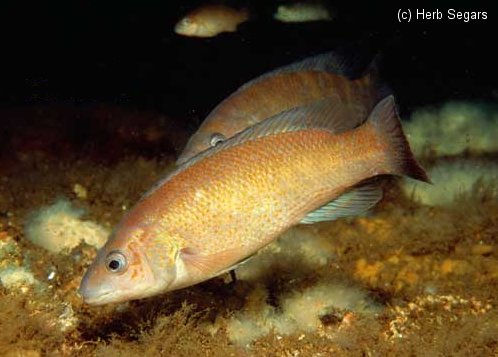
This is the single most common fish seen by divers in our area, and possibly the most amusing as well. In many places, hordes of small cunners seem to drive away all the more desirable fishes. They are bold and aggressive, to the point of even nipping at exposed fingers! they are also inquisitive and easily approached.
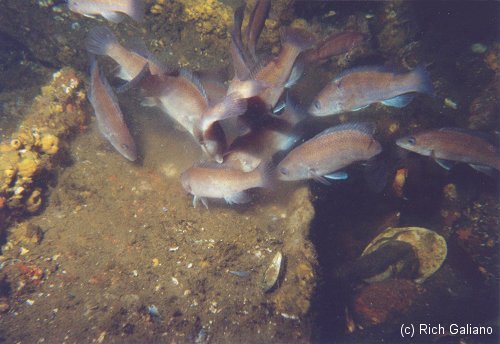
Cunners attacking a mussel that I smashed. I have an old article from one of the glossy dive magazines that calls these fish "shy". Hardly - a lot they know!
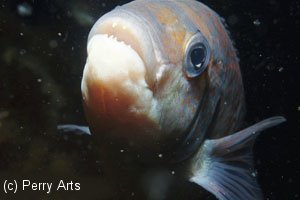
Some cunners seem to enjoy having their picture taken, like the one at right. Perhaps the reflection from the lens looked like something edible. Note the choppers.
You can cause a feeding frenzy among cunners by smashing a few mussels with the back end of your knife. You can even trap them in your goody bag this way, which is fun, but there's no point in keeping them, so just let them go when you are done proving the superiority of hairless apes over fish.
I have amused myself on many an otherwise crummy low-viz dive just by playing games with these bold and obliging little fishes. They don't ever seem to get tired of you, especially if food is involved. When hunting for more desirable prey, I just swat the cunners out of the way with the side of the spear, and sometimes it is amazing how many times you have to bop one of these guys before he gets the message!
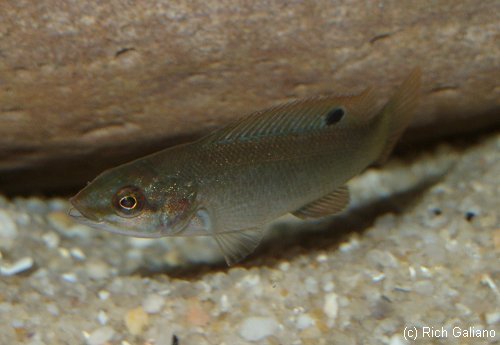
A baby cunner, cute but nippy. They also come in shades of pink.
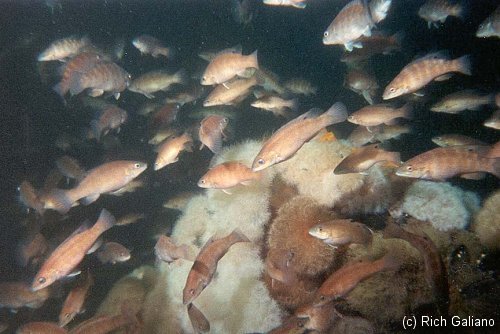
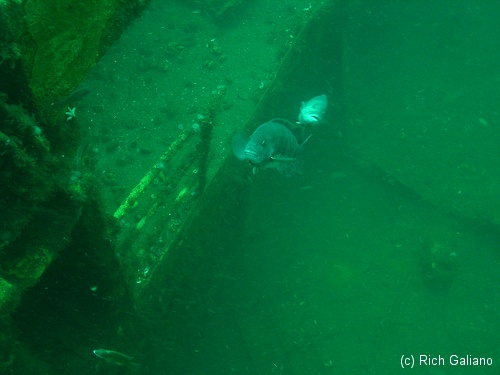
Looking down off the port bridge wing of the Algol at the deck below. The leading cunner swam up and bit me right after I took this picture. They really are little bastards.


